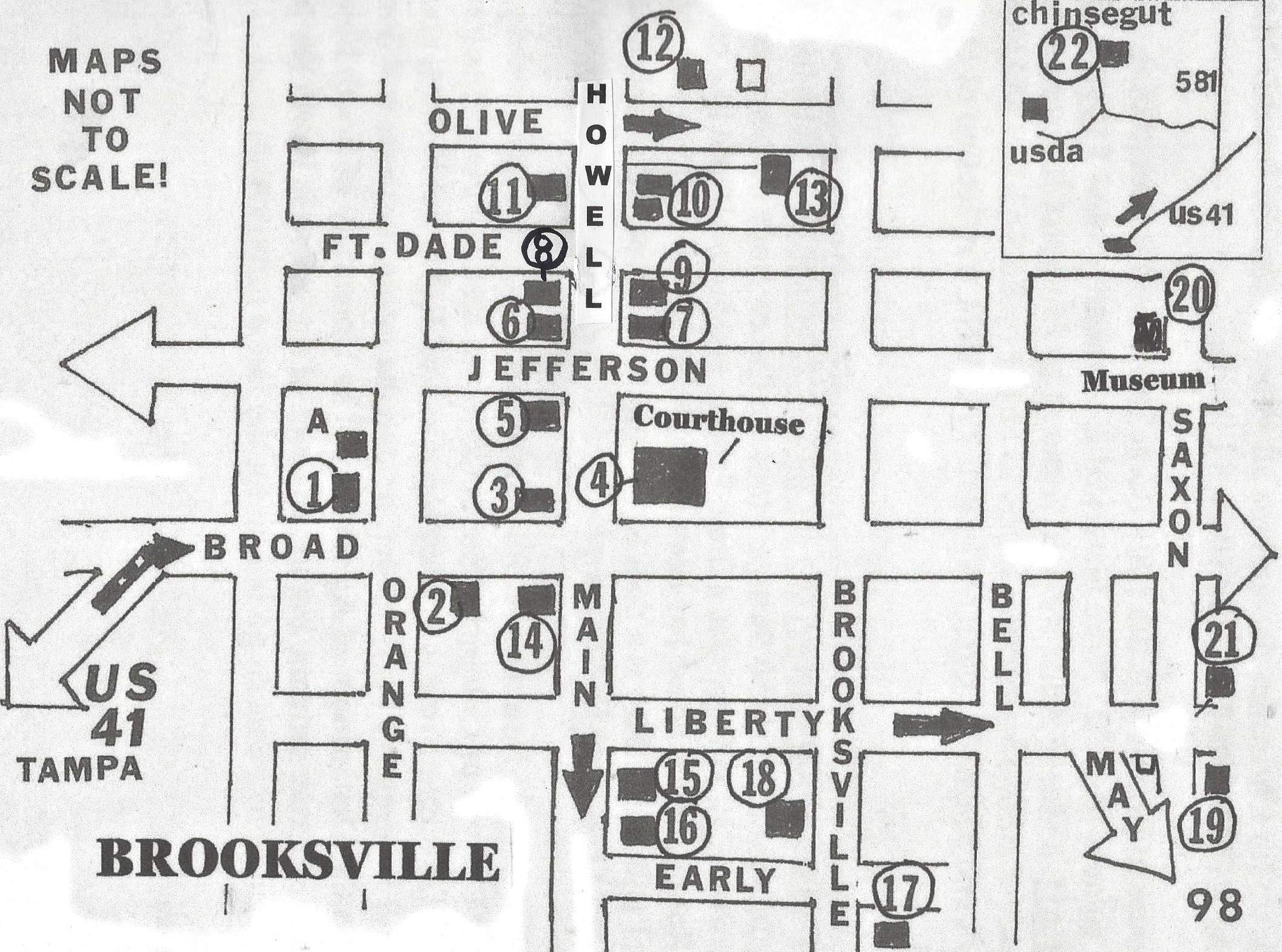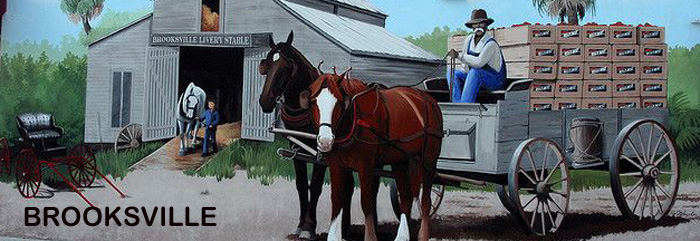|
BROOKSVILLE
(Hernando County)
OLD TIME CITY ON A HILL
For more information about Brooksville and Hernando County, visit: HERNANDO COUNTY CHAMBER OF COMMERCE; and HERNANDO SUN
BROOKSVILLE, originally known as Melendez and then Benton, is a
wonderful city of hills, ranging in elevation from 175 to 274 feet. Coupled
with its condensed area (2.77 square miles) and its long history of successful
planters, growers, and cattlemen, Brooksville is more a reflection of "the
Old South" than other West Coast towns. Brooksville grew from two
communities: Fort
DeSoto
and Pierceville. The town started in 1856 and there are many pre-1900 buildings in the downtown area. Its Southern background is reflected
in its name, honoring South Carolina Congressman Preston Brooks who is best
noted for hitting abolitionist Senator Charles Sumner on the head with Sumner's cane.

WHERE TO START: Enter
Brooksville from the south on US41 (BROAD
STREET), reaching downtown from the east.
Just past Lemon Street, you'll notice on FIRST METHODIST CHURCH,
109 South Broad which was organized in 1891.
CROSS ORANGE, unless you wish to take a short
detour north on Orange to the JOHN J. HALE HOUSE (A), a 3-story
1888 frame house owned by a merchant and railroad trustee. Note how the
breezeway that once separated the kitchen is enclosed.
At 31 Broad is the PRESBYTERIAN CHURCH
BUILDING, converted in 1947 by Henry Carlton Sr. into new location for
his grocery founded in 1910. Up the road
at 120 Broad is the DIXIE THEATER
(1926), where the only talkies are businessmen doing commerce.
The next intersection is the center of
Brooksville. At 1 Main Street
is the FIRST NATIONAL BANK (1910), a two-story brick structure
with its original cast iron columns. On
the south-side of Broad you should see the massive wall mural of “The Brooksville Raid” by Antonio Caparello.
Brooksville has several neat historic murals in the downtown area.
WHERE TO EAT: Brooksville's restaurants are spread out, but across from the Courthouse there are some friendly spots like the MAIN STREET EATERY at 101 North Main, and the DOWNTOWN LOSER at 10 South Broad Street, a healthy food restaurant.
In the northeast corner stands the HERNANDO
COUNTY COURTHOUSE (1913), a rectangular Classical Revival brick edifice
designed by William A. Edwards, complete with Ionic columns. Despite two major additions over the years, the courthouse has remained one of the most photographed public buildings in Florida. The third floor was added in 1974.
TURN LEFT (north) ON MAIN STREET (called Howell above Broad). At
115 North Main is R.R. DINGLE
DEPARTMENT STORE (1912), one of the early large firms. CROSS JEFFERSON STREET.
On your left is BACON'S DRUGS (1926) at 101 North Main, and on your right the
notable HERNANDO STATE BANK (1905), where J. A. Jennings was
first President prior to its purchase in 1907 by William McKethan.
At 115 North Howell
is WEEKS HARDWARE (1913), a two-story brick owned by John Weeks,
first President of the First Federal Bank. Across the street is the J. M.
ROGERS DEPARTMENT STORE (1912), 120 North
Howell.


Downtown Brooksville is very compact but it is quite hilly terrain.


Once St Anth Catholic Church * * Lovely Chinsegut Hill Plantation
CROSS FORT DADE. On the right you can stop and get more local
information at the CHAMBER OF COMMERCE .
101 Ft. Dade Avenue,
or at the nearby 1950 FREDERICK EUGENE LYKES JR LIBRARY, a great resource for local history..
As you go north the road
curves and becomes Howell. At 201 Howell
is the 1970 CITY HALL. The building also houses the City Hall Art Gallery, a neat combination. At 253 North Howell
(Howell) is the W. A. FULTON HOUSE (1880), a lovely 2-story
double verandah home of the organizer of the Florida Citrus Exchange. Lawyer E.
S. MacKenzie was a long owner. Look carefully to see where the dog trot
design once existed. At 307 Howell is
the TANGERINE PLACE (1925), a
mission style hotel where in 1931 City Attorney Herbert Smithson was gunned
down by rum-runners. No one was ever convicted. Across the street at 310 Howell is the 1905 ROY CLEF HOUSE a lovely Colonial Revival.
Brooksville's residential streets are lined
with interesting buildings. If you are driving you might want to go block by block as far as Bell Avenue, where the OLD HERNANDO H.S. (1925) is located. If walking, I would but SKIP tree-lined IRENE (you can see it
later) and TURN RIGHT ON OLIVE
STREET. At 61 Olive is the ST ANTH CATHOLIC
CHURCH (1908). nicely converted into a cool, private
dwelling. (I found there is a church cemetery in the backyard.) At 48 Olive is the most noted Brooksville home, the residence of GOVERNOR WILLIAM SHERMAN JENNINGS (1880),
originally the Roer House. The three-story frame
house has a wonderful octagonal bay tower and is in fine condition. Jennings was Governor in 1900 and his wife May Mann, a leader for women's rights, started the Florida League of Women's Voters.
GO DOWN BROADWAY and turn into IRENE where you’ll
love the old road and the W.E. LAW
HOUSE (1890) a Colonial Revival at 58 Irene. The backside of the larger Olive Street houses shows some old barns.
RETURN TO MAIN STREET, heading
south past the Courthouse.
At the southeast corner at 2 Broad
Street is the J. A.
JENNINGS BUILDING
(1915), a two-story brick vernacular started by the city's first clerk (1880). South Main has a lot of older commercial buildings including the 1885 GRIMSLEY COUNTRY STORE BUILDING, at 100 S. Main. At 131 South Main is the 1931 BROOKSVILLE WOMAN'S CLUB
CROSS LIBERTY STREET. At 140
South Main is DOGWOOD STATION (1919),
a popular place to shop. At 210 South Main is MONTAINEER
ANTIQUES (1925) in a classic Sears & Roebuck catalog house.
TURN RIGHT ON EARLY and drive to BROOKSVILLE/MAGNOLIA. TURN RIGHT to see
the fine OWEN WHITEHURST HOUSE (1896), 321 South
Brooksville, a two-story double veranda house. TURN AROUND GOING ORTH ON
BROOKSVILLE to 133 South Brooksville
and the COOGLER HOUSE (1910). Theodore Coogler
came from South Carolina
as an early settler. Colonel F. B. Coogler was the
town's first treasurer (1880).
YOU’LL
NEED YOUR CAR TO DRIVE EAST ON
LIBERTY: At Liberty
and Saxon Avenue
is the famous: ROGERS FOUR SEASONS GIFT SHOP, 103 Saxon Avenue. For years Mary Roger's Christmas
gift shop was a regional attraction and people came here to stock up for Christmas decorations all-year. Across the street is MALLIE KYLAS CAFE (352-796-7174) at 510 East Liberty.
The main house at Rogers was the 1905 Book Shop until it started
in the Christmas business in 1972. More historical
is the nearby 1864 FRANK SAXON
HOMESTEAD, a Queen Anne Revival restored by Margaret Rogers of the
store. The big business around here today seems to be the rustic SAXON MANOR WEDDINGS and SHABBY CHIC WEDDING BARN, a reflection of changing popularities.
YOU MUST VISIT
the HERNANDO HERITAGE MUSEUM, 601 Museum Court off
Jefferson, located in the 1850 Stringer House, a Queen
Anne masterpiece with a four-story tower. F. L. Stringer was a State Senator
and judge. If you like haunted places, this Springer-May house has been a YouTube feature for TV ghost shows for many years. I will admit there is a door in the small child's room that keeps opening and closing and I could not find any explanation.
There's exhibits and historic artifacts.
CHINSEGUT
HILL, located five miles north
off US41 by Lake Lindsey. Colonel Byrd Pearson of Columbia, South
Carolina, founded the plantation. His daughter wed
Governor Francis P. Fleming. Colonel Raymond Robins, social economist and
Progressive Party leader, owned the estate for years and donated 2,000 acres to
the Department of Agriculture. The University
of South Florida uses the
mansion for private retreats, but the exterior of the house is worth the trip. There are lodging programs so go online for the latest information.






